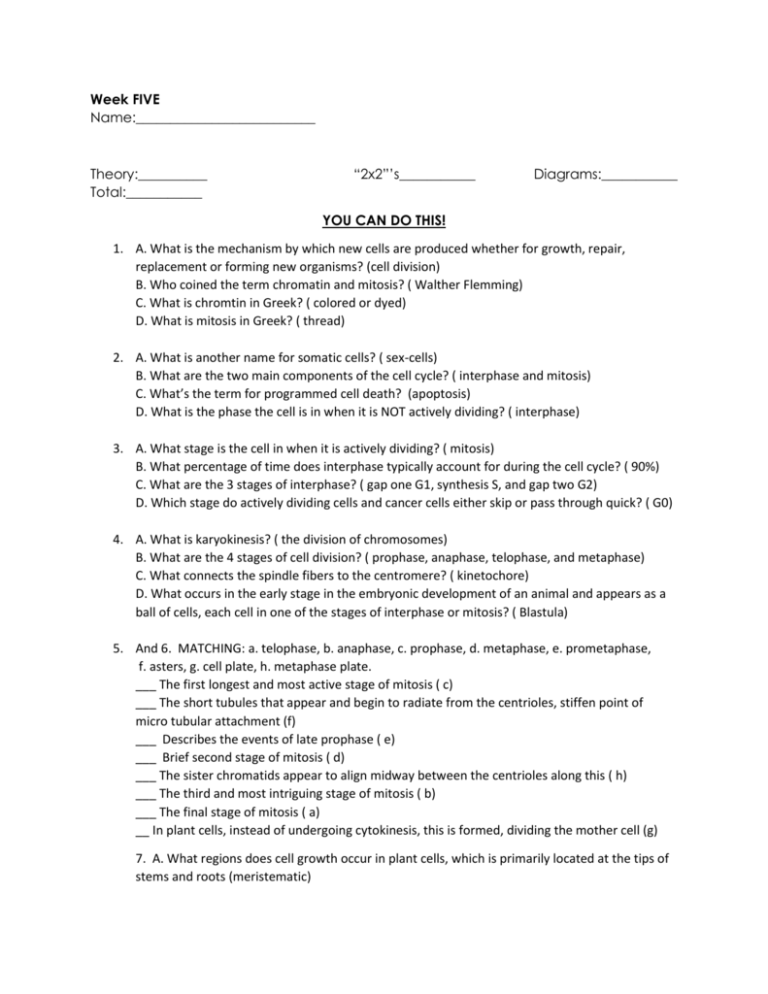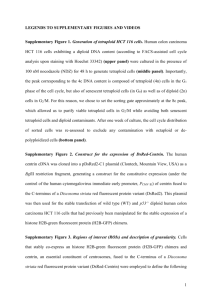Week 5 key
advertisement

Week FIVE Name:__________________________ Theory:__________ Total:___________ “2x2”’s___________ Diagrams:___________ YOU CAN DO THIS! 1. A. What is the mechanism by which new cells are produced whether for growth, repair, replacement or forming new organisms? (cell division) B. Who coined the term chromatin and mitosis? ( Walther Flemming) C. What is chromtin in Greek? ( colored or dyed) D. What is mitosis in Greek? ( thread) 2. A. What is another name for somatic cells? ( sex-cells) B. What are the two main components of the cell cycle? ( interphase and mitosis) C. What’s the term for programmed cell death? (apoptosis) D. What is the phase the cell is in when it is NOT actively dividing? ( interphase) 3. A. What stage is the cell in when it is actively dividing? ( mitosis) B. What percentage of time does interphase typically account for during the cell cycle? ( 90%) C. What are the 3 stages of interphase? ( gap one G1, synthesis S, and gap two G2) D. Which stage do actively dividing cells and cancer cells either skip or pass through quick? ( G0) 4. A. What is karyokinesis? ( the division of chromosomes) B. What are the 4 stages of cell division? ( prophase, anaphase, telophase, and metaphase) C. What connects the spindle fibers to the centromere? ( kinetochore) D. What occurs in the early stage in the embryonic development of an animal and appears as a ball of cells, each cell in one of the stages of interphase or mitosis? ( Blastula) 5. And 6. MATCHING: a. telophase, b. anaphase, c. prophase, d. metaphase, e. prometaphase, f. asters, g. cell plate, h. metaphase plate. ___ The first longest and most active stage of mitosis ( c) ___ The short tubules that appear and begin to radiate from the centrioles, stiffen point of micro tubular attachment (f) ___ Describes the events of late prophase ( e) ___ Brief second stage of mitosis ( d) ___ The sister chromatids appear to align midway between the centrioles along this ( h) ___ The third and most intriguing stage of mitosis ( b) ___ The final stage of mitosis ( a) __ In plant cells, instead of undergoing cytokinesis, this is formed, dividing the mother cell (g) 7. A. What regions does cell growth occur in plant cells, which is primarily located at the tips of stems and roots (meristematic) B. What is the underlying mechanism behind sexual reproduction? ( meosis) C. Sex cells are also referred to as what? ( gametes) D. The total number of chromosomes in the nucleus of a cell is called the what? ( diploid number) 8. A. What is the diploid number for a goldfish? (94) B. What is the diploid number for corn? (20) C. What is the diploid number for humans? ( 46) D. What is the haploid number for humans? ( 23) 9. A. What involves the reduction of the diploid state (2n) to the haploid state (n)? (meiosis) B. The union of haploid male and female gametes to form a diploid zygote is? ( fertilization C. In the first stage in meiosis I, homologous chromosomes pair up in a process called what? (synapsis) D. What does meiosis II result in? (division of the sister chromatids from meiosis) 10. A. What does dioecious mean? ( have separate sexes) B. This is the production of sperm that occurs in the seminiferous tubules in the testes? ( spermatogenesis) C. What’s another name for primordial germ cells? ( diploid cells) D. The secondary oocyte begins what? (meiosis II) 11. A. In human males, diploid primordial germ cells divide by mitosis to form diploid what? (spermatogonia) B. How long does the process of spermatogenesis, including spermiogenesis last? (2 month) C. How many million sperm are produced during each human ejaculation? ( 200-600) D. Unfortunatley, 1 in 250 births exhibit aneuploidy, resulting in an individual with the wrong number of what? ( chromosomes) 12. A. What kind of reproduction do plants carry out? (sexual) B. Where does meiosis occur in female plants? ( ovary) C. What does 2n stand for? ( sporophyte generation) D. What does n stand for? ( gametophyte generation) 13.A. Give and example of a sporophyte. ( pine tree) B. Who is the father of genetics? ( Gregor Mendel) C. What serve as the origins of modern genetics? ( pea plants) D. Unites of heredity are called what? ( genes) 14. A. What number chromosome is Alzheimer’s disease found on? ( 21) B. What number chromosome has the gene for cystic fibrosis been found on? ( 7) C. How many genes are responsible for producing our traits? ( 20,000-25,000) D. What is it called when two identical alleles are identical? (homozygous) 15. A. What is it called when an individual possesses two different alleles? ( heterozygous) B. What law states that during the formation of sex cells, the alleles responsible for each trait separate so that each gamete contains only one allele for that trait? ( Law of segregation) C. What are Punnett squares used for? (To make predictions about expected results based upon laws of probability) D. True or False: evolution occurs at the level of individuals. (false, at the level of population) 16. A. Allele frequencies are expressed as a fraction of what? ( 1.0) B. When is a gene in genetic equilibrium? ( when the frequency of alleles for a gene are constant over time…( no change in allele frequency) C and D List the conditions that need to be met in order for genetic equilibrium to be maintained in a population. HINT: there are 5! ( No mutation, no movement of individuals into or out of the population, mating must be random, population must be large, there is no selection.) 17. A. What is the equation proportions can be estimated by? ( p^2+2pq+q^2= 1.0) B. What is the marbling observed in some kernels of corn a result of? (transposons or jumping genes) C. Who was the first American woman to win an unshared Nobel Prize? ( Barbara McClintock) D. How many kernels does an ear of corn have? (800) 18. A. How many pounds of corn a year do Americans consume? (1,500) B. List a product (from your text) that uses corn. ( adhesives, dyes, lipstick, aspirin, crayons, ect) C. What percentage of people are type O blood? (46%) D. 4% of people have what blood type? (AB) 19+20 MATCHING a. b. c. d. e. f. g. h. Bent little finger Widow’s Peak Finger hair Thumb crossing Tongue rolling Dimpled chin Free earlobe Hitchhiker’s thumb ____ (c) You have the dominate ‘H” allele for mid-digital hair ____ (a) Clinodactyly ____( e) The gene for this is “R” ____ (f) The presence of this results in a dominate “D” gene ____ (b) Think of Count Dracula or Eddie Munster ____ (h) the ability to bend your thumb at a 60 degree angle ____(d) If your left thumb is uppermost, you possess a dominant gene “T” ____ (g) Dominant gene “E” BONUS: What do Soli and JoJo call Andrea and Kathryn? What is Kathryn’s special friend’s name? What NBA did Kathryn’s special friend’s dad play for? What is the best season EVER? HINT: SNOW SNOW SNOW SNOW










